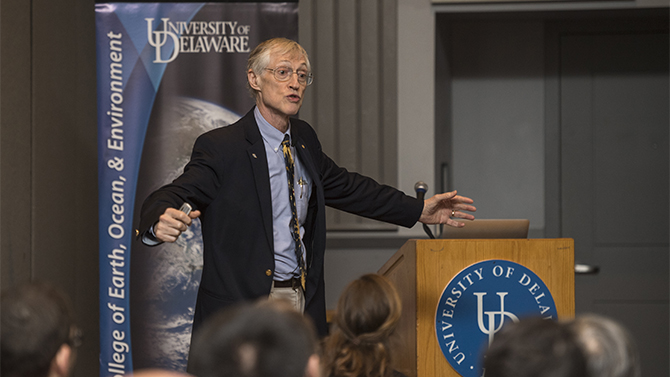


An eye on the universe
Photo by Kathy F. Atkinson April 18, 2017
Astrophysicist discusses work on ‘revolutionary’ new telescope
John C. Mather, who won the 2006 Nobel Prize in Physics for his work in understanding the origins of the universe, spoke at the University of Delaware on April 13 about the newest tool to further that understanding.
Mather is leading a team of scientists at work on the James Webb Space Telescope (JWST), an international effort by thousands of scientists, engineers and technicians to develop the most powerful space telescope ever built. The giant device will be “our new eye on the universe” once it deploys from French Guiana in October 2018, Mather said.
The telescope, now under construction at NASA’s Goddard Space Flight Center, will be the successor to the Hubble Space Telescope, which has been sending valuable data to scientists for 27 years and, Mather noted, is still “working well and not about to run down.”
But the new, larger and more powerful telescope is needed, he said, because astrophysicists’ theories and computer models can go only so far in figuring out the secrets of the universe.
“Practically everything we know about astronomy was a surprise” when it was discovered, he said. “There’s no answer in the back of the book; you have to go measure it.”
The JWST’s mission will be to make those measurements, studying every phase of the universe’s history as it orbits the sun, a million miles from Earth.
Scientists hope to use its data over the next decade to find the first galaxies and luminous objects from just after the Big Bang and to observe how structures — from stars to black holes and whole galaxies — formed and evolved into today’s universe. They also hope to measure the solar system and exoplanetary systems from a physical and chemical perspective, to help understand the origin of life here and the possibilities for life elsewhere.
By viewing the universe at infrared wavelengths, JWST will be able to show observers things that no other telescope has seen.
Mather outlined the long and painstaking process of building the telescope. When it was first envisioned, he said, 10 brand-new technologies needed to be developed before it could be constructed. “They were,” he said simply.
Between now and its deployment, the telescope will travel from its current location in the world’s largest clean room at Goddard to NASA’s Johnson Space Center in Texas for specialized testing. Next, it will be moved to Northrop Grumman Corp. in California for final assembly and testing and then will travel by ship through the Panama Canal to French Guiana on the northeast coast of South America. There, it will be loaded onto a rocket that it has been folded to fit and launched into space.
“Some of this [work] is much more complicated than anything we’ve done before,” Mather said, emphasizing that there is no room for error at any step of the process. “But we don’t think there’s any other way” to get the data needed for understanding the universe.
The project is a collaboration among NASA and the European and Canadian space agencies, with each organization contributing instruments and expertise. The Goddard center’s responsibilities include overall project management and mission systems engineering.
For more information about the JWST, visit the NASA website.
More about John Mather’s lecture
The talk at UD was hosted by the College of Earth, Ocean, and Environment (CEOE) and coordinated in collaboration with the Department of Physics and Astronomy in the College of Arts and Sciences.
In introducing Mather, Mohsen Badiey, acting dean of CEOE, noted UD’s commitment to interdisciplinary research and education that advances all fields of sciences.
“As an oceanographer, physics is central to my work, and I am fascinated by the ways our scientific tools bridge our subject matter,” he told the audience. “Whether studying under water or in space, the same ways of understanding nature allow us to make discoveries in any environment.”
Mather was invited to lecture on campus, Badiey said, “in that spirit of recognizing the importance of the sciences, from the skies to the seas.”
Contact Us
Have a UDaily story idea?
Contact us at ocm@udel.edu
Members of the press
Contact us at 302-831-NEWS or visit the Media Relations website

